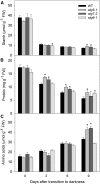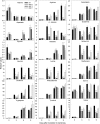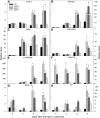Autophagy Deficiency Compromises Alternative Pathways of Respiration following Energy Deprivation in Arabidopsis thaliana
- PMID: 28710132
- PMCID: PMC5580740
- DOI: 10.1104/pp.16.01576
Autophagy Deficiency Compromises Alternative Pathways of Respiration following Energy Deprivation in Arabidopsis thaliana
Abstract
Under heterotrophic conditions, carbohydrate oxidation inside the mitochondrion is the primary energy source for cellular metabolism. However, during energy-limited conditions, alternative substrates are required to support respiration. Amino acid oxidation in plant cells plays a key role in this by generating electrons that can be transferred to the mitochondrial electron transport chain via the electron transfer flavoprotein/ubiquinone oxidoreductase system. Autophagy, a catabolic mechanism for macromolecule and protein recycling, allows the maintenance of amino acid pools and nutrient remobilization. Although the association between autophagy and alternative respiratory substrates has been suggested, the extent to which autophagy and primary metabolism interact to support plant respiration remains unclear. To investigate the metabolic importance of autophagy during development and under extended darkness, Arabidopsis (Arabidopsis thaliana) mutants with disruption of autophagy (atg mutants) were used. Under normal growth conditions, atg mutants showed lower growth and seed production with no impact on photosynthesis. Following extended darkness, atg mutants were characterized by signatures of early senescence, including decreased chlorophyll content and maximum photochemical efficiency of photosystem II coupled with increases in dark respiration. Transcript levels of genes involved in alternative pathways of respiration and amino acid catabolism were up-regulated in atg mutants. The metabolite profiles of dark-treated leaves revealed an extensive metabolic reprogramming in which increases in amino acid levels were partially compromised in atg mutants. Although an enhanced respiration in atg mutants was observed during extended darkness, autophagy deficiency compromises protein degradation and the generation of amino acids used as alternative substrates to the respiration.
© 2017 American Society of Plant Biologists. All Rights Reserved.
Figures








Similar articles
-
Commonalities and differences in plants deficient in autophagy and alternative pathways of respiration on response to extended darkness.Plant Signal Behav. 2017 Nov 2;12(11):e1377877. doi: 10.1080/15592324.2017.1377877. Epub 2017 Sep 21. Plant Signal Behav. 2017. PMID: 28933654 Free PMC article.
-
Autophagy contributes to nighttime energy availability for growth in Arabidopsis.Plant Physiol. 2013 Apr;161(4):1682-93. doi: 10.1104/pp.113.215632. Epub 2013 Mar 1. Plant Physiol. 2013. PMID: 23457226 Free PMC article.
-
Vacuolar Protein Degradation via Autophagy Provides Substrates to Amino Acid Catabolic Pathways as an Adaptive Response to Sugar Starvation in Arabidopsis thaliana.Plant Cell Physiol. 2018 Jul 1;59(7):1363-1376. doi: 10.1093/pcp/pcy005. Plant Cell Physiol. 2018. PMID: 29390157
-
Protein degradation - an alternative respiratory substrate for stressed plants.Trends Plant Sci. 2011 Sep;16(9):489-98. doi: 10.1016/j.tplants.2011.05.008. Trends Plant Sci. 2011. PMID: 21684795 Review.
-
Algal Autophagy Is Necessary for the Regulation of Carbon Metabolism Under Nutrient Deficiency.Front Plant Sci. 2020 Feb 5;11:36. doi: 10.3389/fpls.2020.00036. eCollection 2020. Front Plant Sci. 2020. PMID: 32117375 Free PMC article. Review.
Cited by
-
An L,L-diaminopimelate aminotransferase mutation leads to metabolic shifts and growth inhibition in Arabidopsis.J Exp Bot. 2018 Nov 26;69(22):5489-5506. doi: 10.1093/jxb/ery325. J Exp Bot. 2018. PMID: 30215754 Free PMC article.
-
Autophagic pathway contributes to low-nitrogen tolerance by optimizing nitrogen uptake and utilization in tomato.Hortic Res. 2022 Mar 23;9:uhac068. doi: 10.1093/hr/uhac068. eCollection 2022. Hortic Res. 2022. PMID: 35669705 Free PMC article.
-
Proteomic and metabolomic analysis of Nicotiana benthamiana under dark stress.FEBS Open Bio. 2022 Jan;12(1):231-249. doi: 10.1002/2211-5463.13331. Epub 2021 Dec 16. FEBS Open Bio. 2022. PMID: 34792288 Free PMC article.
-
Dynamic organelle changes and autophagic processes in lily pollen germination.Bot Stud. 2024 Jan 26;65(1):5. doi: 10.1186/s40529-024-00410-6. Bot Stud. 2024. PMID: 38273136 Free PMC article.
-
SlMYB72 affects pollen development by regulating autophagy in tomato.Hortic Res. 2022 Dec 29;10(3):uhac286. doi: 10.1093/hr/uhac286. eCollection 2023 Mar. Hortic Res. 2022. PMID: 36938568 Free PMC article.
References
-
- Araújo WL, Ishizaki K, Nunes-Nesi A, Larson TR, Tohge T, Krahnert I, Witt S, Obata T, Schauer N, Graham IA, et al. (2010) Identification of the 2-hydroxyglutarate and isovaleryl-CoA dehydrogenases as alternative electron donors linking lysine catabolism to the electron transport chain of Arabidopsis mitochondria. Plant Cell 22: 1549–1563 - PMC - PubMed
-
- Araújo WL, Tohge T, Ishizaki K, Leaver CJ, Fernie AR (2011) Protein degradation: an alternative respiratory substrate for stressed plants. Trends Plant Sci 16: 489–498 - PubMed
-
- Avila-Ospina L, Moison M, Yoshimoto K, Masclaux-Daubresse C (2014) Autophagy, plant senescence, and nutrient recycling. J Exp Bot 65: 3799–3811 - PubMed
MeSH terms
LinkOut - more resources
Full Text Sources
Other Literature Sources
Molecular Biology Databases

